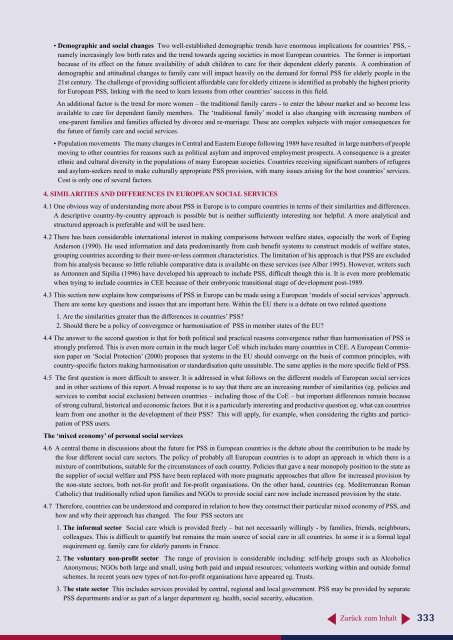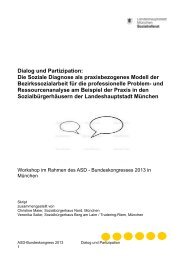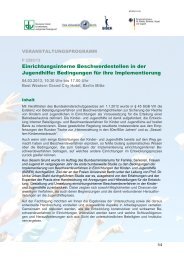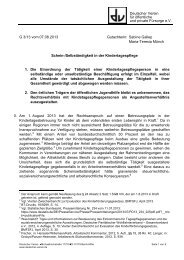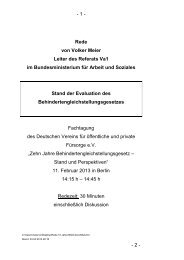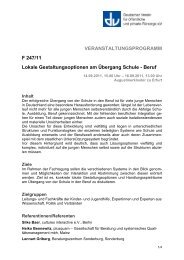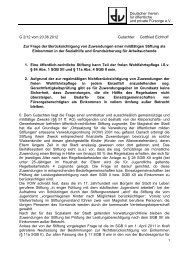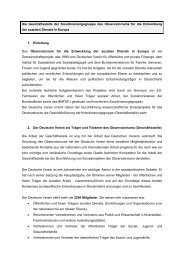Workshop 1.6 - Deutscher Verein für öffentliche und private Fürsorge
Workshop 1.6 - Deutscher Verein für öffentliche und private Fürsorge
Workshop 1.6 - Deutscher Verein für öffentliche und private Fürsorge
Sie wollen auch ein ePaper? Erhöhen Sie die Reichweite Ihrer Titel.
YUMPU macht aus Druck-PDFs automatisch weboptimierte ePaper, die Google liebt.
• Demographic and social changes Two well-established demographic trends have enormous implications for countries’ PSS, -<br />
namely increasingly low birth rates and the trend towards ageing societies in most European countries. The former is important<br />
because of its effect on the future availability of adult children to care for their dependent elderly parents. A combination of<br />
demographic and attitudinal changes to family care will impact heavily on the demand for formal PSS for elderly people in the<br />
21st century. The challenge of providing sufficient affordable care for elderly citizens is identified as probably the highest priority<br />
for European PSS, linking with the need to learn lessons from other countries’ success in this field.<br />
An additional factor is the trend for more women – the traditional family carers - to enter the labour market and so become less<br />
available to care for dependent family members. The ‘traditional family’ model is also changing with increasing numbers of<br />
one-parent families and families affected by divorce and re-marriage. These are complex subjects with major consequences for<br />
the future of family care and social services.<br />
• Population movements The many changes in Central and Eastern Europe following 1989 have resulted in large numbers of people<br />
moving to other countries for reasons such as political asylum and improved employment prospects. A consequence is a greater<br />
ethnic and cultural diversity in the populations of many European societies. Countries receiving significant numbers of refugees<br />
and asylum-seekers need to make culturally appropriate PSS provision, with many issues arising for the host countries’ services.<br />
Cost is only one of several factors.<br />
4. SIMILARITIES AND DIFFERENCES IN EUROPEAN SOCIAL SERVICES<br />
4.1 One obvious way of <strong>und</strong>erstanding more about PSS in Europe is to compare countries in terms of their similarities and differences.<br />
A descriptive country-by-country approach is possible but is neither sufficiently interesting nor helpful. A more analytical and<br />
structured approach is preferable and will be used here.<br />
4.2 There has been considerable international interest in making comparisons between welfare states, especially the work of Esping<br />
Anderson (1990). He used information and data predominantly from cash benefit systems to construct models of welfare states,<br />
grouping countries according to their more-or-less common characteristics. The limitation of his approach is that PSS are excluded<br />
from his analysis because so little reliable comparative data is available on these services (see Alber 1995). However, writers such<br />
as Antonnen and Sipilia (1996) have developed his approach to include PSS, difficult though this is. It is even more problematic<br />
when trying to include countries in CEE because of their embryonic transitional stage of development post-1989.<br />
4.3 This section now explains how comparisons of PSS in Europe can be made using a European ‘models of social services’ approach.<br />
There are some key questions and issues that are important here. Within the EU there is a debate on two related questions<br />
1. Are the similarities greater than the differences in countries’ PSS?<br />
2. Should there be a policy of convergence or harmonisation of PSS in member states of the EU?<br />
4.4 The answer to the second question is that for both political and practical reasons convergence rather than harmonisation of PSS is<br />
strongly preferred. This is even more certain in the much larger CoE which includes many countries in CEE. A European Commission<br />
paper on ‘Social Protection’ (2000) proposes that systems in the EU should converge on the basis of common principles, with<br />
country-specific factors making harmonisation or standardisation quite unsuitable. The same applies in the more specific field of PSS.<br />
4.5 The first question is more difficult to answer. It is addressed in what follows on the different models of European social services<br />
and in other sections of this report. A broad response is to say that there are an increasing number of similarities (eg. policies and<br />
services to combat social exclusion) between countries – including those of the CoE – but important differences remain because<br />
of strong cultural, historical and economic factors. But it is a particularly interesting and productive question eg. what can countries<br />
learn from one another in the development of their PSS? This will apply, for example, when considering the rights and participation<br />
of PSS users.<br />
The ‘mixed economy’ of personal social services<br />
4.6 A central theme in discussions about the future for PSS in European countries is the debate about the contribution to be made by<br />
the four different social care sectors. The policy of probably all European countries is to adopt an approach in which there is a<br />
mixture of contributions, suitable for the circumstances of each country. Policies that gave a near monopoly position to the state as<br />
the supplier of social welfare and PSS have been replaced with more pragmatic approaches that allow for increased provision by<br />
the non-state sectors, both not-for profit and for-profit organisations. On the other hand, countries (eg. Mediterranean Roman<br />
Catholic) that traditionally relied upon families and NGOs to provide social care now include increased provision by the state.<br />
4.7 Therefore, countries can be <strong>und</strong>erstood and compared in relation to how they construct their particular mixed economy of PSS, and<br />
how and why their approach has changed. The four PSS sectors are<br />
1. The informal sector Social care which is provided freely – but not necessarily willingly - by families, friends, neighbours,<br />
colleagues. This is difficult to quantify but remains the main source of social care in all countries. In some it is a formal legal<br />
requirement eg. family care for elderly parents in France.<br />
2. The voluntary non-profit sector The range of provision is considerable including: self-help groups such as Alcoholics<br />
Anonymous; NGOs both large and small, using both paid and unpaid resources; volunteers working within and outside formal<br />
schemes. In recent years new types of not-for-profit organisations have appeared eg. Trusts.<br />
3. The state sector This includes services provided by central, regional and local government. PSS may be provided by separate<br />
PSS departments and/or as part of a larger department eg. health, social security, education.<br />
Zurück zum Inhalt<br />
333


